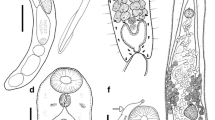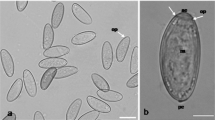Abstract
Metacercarial cysts ofParorchis acanthus preserved in sea water have a much greater longevity and a greater capacity to excyst in vitro and in vivo than those preserved under dry conditions. Increasing temperatures reduce the viability and excystment rate of the metacercariae. After encystment, metacercariae must reach a minimum age before they can excyst in vivo or in vitro and be infective. Maximum percentage excystment varies with the temperature of the environment and decreases with increasing temperatures. Not all metacercariae can excyst even when they are alive and are sufficiently activated. The chief sites for the excystment ofP. acanthus metacercariae in vivo are the duodenum and intestine. The in vitro excystment results corroborate with those obtained in vivo.
Similar content being viewed by others
References
Asanji MF, Williams MO (1974) Studies on the excystment of metacercariae in vivo. J Helminol 48: 85–91
Asanji MF, Williams MO (1975) Studies on the excystment of metacercariae in vitro. Z Parasitenkd 47: 151–163
Bitakaramire PK (1968)Lymnaea natalensis laboratory culture and production ofFasciola hepatica metacercariae. Parasitology 58: 653–656
Danley LD (1973) The Harderian gland and site-finding by metacerariae ofPhilophthalmus megalurus (Trematoda: Digenea). J Parasitol 59(3): 457–462
Davies C, Smyth JD (1978) In vitro cultivation ofFasciola hepatica metacercariae and of partially developed flukes recovered from mice. Int J Parasitol 8(2): 125–131
Fried B (1973) Infectivity, growth and development ofParorchis acanthus (Trematoda) in domestic chicks. J Parasitol 59: 743–744
Fried B, Roth RM (1974) In vitro excystment of metacercariae ofParorchis acanthus. J Parasitol 60(3): 465
Fried B, Wilson BD (1981) Survival of metacercariae ofZygocotyle lunata (Trematoda) in half-strength Locke's solution under refrigeration. Proc Helminol Soc Was 84(1): 96–97
Griffiths HJ, Christensen AC (1972) Survival of metacercariae ofFascioloides magna in water at room temperature and under refrigeration. J Parasitol 58: 404–405
Griffiths HJ, Christensen AC (1974) Further observations on the survival ofFascioloides magna in water at room temperature and under refrigeration. J Parasitol 60(2): 335
Kendall SB (1965) Relationships between the species ofFasciola hepatica and their molluscan hosts. Adv Parasitol 3: 59–95
Lengy G (1960) Studies onParamphistomum microbothrium Fischoeder, 1901, a rumen parasite of cattle in Israel. Res Cour Israel (Sect. B) 9: 71–130
Milian SF, Ibarra VF, Flores-Crespos R (1981) The viability and infectivity ofFasciola hepatica metacercariae of different ages. Tecnica Pecuaria en Mexico 41: 73–75
Mitchell JB, Mason AR, Peat A (1974), Observations on the encystment and excystment ofGorgoderina vitilloba (Abstract). Parasitology 69(2): 8
Olsen OW (1947) Longevity of metacercariae ofFasciola hepatica on pasture in the upper coast region of Texas and its relationship to liver fluke control. J Parasitol 33: 35–42
Ross IC, Mackay AC (1929) The bionomics ofFasciola hepatica in New York Wales and of the intermediate hosts,Lymnaea brazieri. Bull Counc Sci Industr Res Aust 43: 1–62
Shaw JN (1932) Studies of the liver flukeFasciola hepatica. J Am Vet Med Ass 81: 76–82
Shirai M (1927) The biological observations on the cysts ofFasciola hepatica and the route of migration of young worms in the final host. Sci Rep Inst Inf Dis Tokyo University 6: 511–524
Smyth JD (1966) The physiology of trematodes. Freeman, San Francisco, p. 256
Williams MO (1968) Cercaria ofParorchis acanthus in marine molluses in Sierra Leone with notes on the survival of the carcariae and development of the metacercariae in a definitive host. Rev Zool Bot Afr 49(3/4): 266–272
Yokogawa M, Suguro T, Yoshimma H, Tauji M (1960) Studies on the experimental infection of dogs with three metacercariae ofParagonimus westermani. J Parasitol 46(5) Suppl: 35
Youssef M, Mansour NS, Hammouda NA, Awadalla HN, Boulos LM (1981) Effect of freezing and grilling onPygidiopsis genala metacercariae inTilapia. J Egypt Parasitol 11(2): 425–428
Author information
Authors and Affiliations
Rights and permissions
About this article
Cite this article
Asanji, M.F., Williams, M.O. Effect of age and environmental factors on the viability and excystment of metacercarial cysts ofParorchis acanthus in vivo and in vitro. Z. Parasitenkd. 71, 595–601 (1985). https://doi.org/10.1007/BF00925592
Accepted:
Issue Date:
DOI: https://doi.org/10.1007/BF00925592




